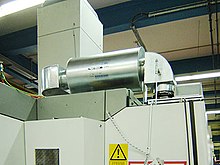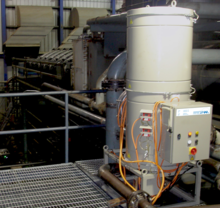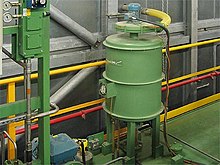Oil mist separator
The oil mist separator device to have deposition of aerosols (z. B. cooling lubricants, engine oil) in gaseous media (eg., Air, blow-by ) and are used in many applications. There are different ways in which oil mist separators work. The degrees of separation of these differ greatly. Choosing the right type of oil mist separator depends on the requirements of the application and environmental regulations. The term oil separator is often used for oil mist separators , although this is generally used more for the separation of liquids.
application areas
Industrial production processes
Oil mist separators, smoke mist separators (RNA), emulsion mist separators are separators or filter systems for separating or filtering out airborne pollutant particles or aerosols that arise in production processes. When machining workpieces, for example with machine tools , the workpieces are often wetted with coolants ( cooling lubricants , KSS). Due to the high processing speeds (e.g. turning the workpiece and / or the tool), a fine oil or emulsion mist (often also smoke) is created. These aerosols are potentially harmful to health (e.g. skin and eye irritation, respiratory diseases), cause damage to capital goods , often increase the fire load of the environment (e.g. due to oil films that promote the spread of fire) and the risk of the formation of explosive substances Atmospheres in the machine work room. As a rule, oil mist separators are used in industrial applications in a closed circuit. The separated - and freed from material particles carried along - is collected and fed back into the machining process, the clean gas is fed into the workshop or, depending on its composition, out of the workshop.
Internal combustion engines
In internal combustion engines , blow-by gases always occur due to their principle . These gases must be removed from the crankcase . When the crankcase is vented , fine oil droplets are carried away. Oil mist separators are often used in order to avoid contamination of engine components and operational malfunctions. If the crankcase ventilation is open , oil mist separators should be used for environmental reasons.
Gas turbines / steam turbines
Turbine bearings are subjected to a slight negative pressure to prevent lubricating oil from leaking into the environment. For this purpose, the lubricating oil tanks are vented , which creates a negative pressure in the entire system. The extracted air contains fine oil mist, this is partly separated by means of an oil mist separator for environmental reasons.
Compressors
Oil-lubricated compressors cause oil to enter the compressed medium (e.g. air, biogas); Depending on the application and the residual oil content, the oil can lead to operational problems, which is why oil mist separators are used to separate the lubricating oil.
Vacuum pumps
Some vacuum pump types are often oil-lubricated (e.g. rotary vane pumps). The oil is used for lubrication and fine sealing. To prevent the oil from escaping with the extracted medium, oil mist separators are sometimes used.
Operating principles of oil mist separators
In general, four groups of separators can be distinguished according to their separation or filter principle. The different operating principles of the four main groups are also used in combination with some devices. Furthermore, the medium to be separated or filtered out is relevant for the technology to be used: In processing machines , emulsions (oil-water mixture with additives) are often used as cooling lubricants , which must be taken into account in terms of air filter technology in order to obtain the most technically and economically efficient filter - / separation process to be selected. For example, electrostatic precipitators are preferred for oil-heavy processing, while filtering separators are preferred for emulsions with a certain oil content.
In practice, if there are very high demands on the degree of purity of the filtered air, filtering separators (e.g. particulate filters , activated carbon , etc.) are connected downstream of a main device. This can also be used as a support measure if the main device, as with centrifugal separators, does not achieve a satisfactory degree of separation due to the operating principle even with normal requirements. The electrostatic principle can also have a restricted function under certain conditions in the case of emulsions, provided that the active principle is not tailored to the medium to be deposited and its composition.
Centrifugal separators and electrostatic precipitators are used as individual devices directly on individual machines, machine groups and for smaller central systems for mist and smoke separation in industry (mostly in the range up to 100,000 m³ / h - centrifugal separators only up to around 3000 m³ / h due to their design), while separators with solids filters are used for local extraction as compact devices as well as for medium to large central systems.
The degree of separation often given is not a sufficient quality feature for a filter system and cannot be used for the comparability of oil mist separators, as there are no standardized specifications for the determination. Degrees of separation are often given without specifying the minimum particle size to which this is based. The decisive factor is the residual oil content in the gas after the oil mist separator. This can be determined relatively easily using a laser photometer, for example. Other methods of determination are, for example, gravimetric recording using an absolute filter or a measuring buoy equipped with special filter paper.
Electrostat, electrostatic precipitator, electrostatic precipitator
Main article: Electrostatic precipitator
In terms of occupational safety , electrostatic separators are more important than the centrifugal separators used more frequently in the past (i.e. inertial separators, filtering separators with rotating filter drums or mini cyclones ), as the maximum workplace concentration of airborne pollutants can be maintained more reliably and operation and maintenance are easier . About 50% of the separators used in metalworking and metalworking companies are electrostatic separators of various designs (see BGIA report 9/2006, p. 10f).
With the help of a fan, electrostatic precipitators direct the smoke and mist-laden air via suction hoses or pipe ducts through mechanical pre-filters (e.g. made of metal or textile ) to filter out larger dirt particles. The remaining particles are then charged electrostatically . In the so-called “collector”, the charged particles settle on the oppositely charged collector plates, with the remaining coolant running down the plates so that it can be reused in the coolant circuit, for example. The advantage of electrostats lies in the separation elements that can be cleaned and that do not wear out. Another advantage is the energy efficiency of the systems, because an electrostatic precipitator cannot “clog” due to its design, so there is only a slight loss of pressure during operation and therefore a far lower performance requirement is placed on the ventilation. With water-mixed cooling lubricants, leakage currents and voltage flashovers can occur.
The use of electrostatic precipitators in combustion engines is not recommended for safety reasons. In isolated cases, electrostatic precipitators were found to be the cause of crankcase explosions.
Centrifuge, centrifugal separator, mass force separator
In centrifuges , the aerosol particles are ejected by a rapidly rotating rotor and separated from the air flow. However, this function is only guaranteed if the particles have sufficient mass. In this respect, most of the smoke passes through the centrifugal separator unfiltered: In temperature-intensive machining processes and in internal combustion engines with high power density, a large part of the particles is very small and light, so that the mass force separation only works to a limited extent. The separated medium is then collected and possibly added back to the circuit or disposed of.
Centrifuges have the disadvantage that they often become unbalanced due to the adhering material abrasion and generate increased maintenance costs. Furthermore, according to investigations carried out by employers' liability insurance associations in Germany , mass force separators lead to “very poor results, sometimes even with negative degrees of separation, due to the renewed emission of substances that have already been separated” (cf. BGIA Report 9/2006, p. 11) or “unsatisfactory results “In aerosol separation (cf. BIA Report 4/2004, p. 33, table 4). In this respect, centrifugal separators only play a subordinate role in modern production processes. Even innovations complained about by some manufacturers cannot outweigh the main disadvantage of the poor degree of separation, which is due to the actual physical operating principle in connection with the current production processes (high smoke and mist development due to high-speed processing, for example). In order to counteract this disadvantage, centrifuges are often followed by small filtering separators, which, however, cannot avoid the disadvantage of a possible imbalance in the centrifuge and so, overall, very often only lead to a suboptimal filter system. Centrifuges for separating cooling lubricant mist are no longer regarded as the state of the art in air filter technology and in occupational safety . Centrifugal separators are currently being used more and more in internal combustion engines in cars and trucks. The problem of oil smoke is not so great and the separation rate is much better compared to the cyclone and impact separators, which are still very widespread in this application segment. The service life of an internal combustion engine is also significantly shorter than that of a machine tool. With the increasing power density of internal combustion engines, however, the principle-related disadvantage of the separation performance of centrifugal separators with regard to very small particles also applies here.
Solids filters, filtering separators
In the case of filtering separators, several filter stages (usually with an increasing degree of separation ) are connected in series so that the airborne pollutant particles or aerosols are filtered out in each individual stage, depending on their size. The remaining lubricant drips from the filter media and can be returned to the circuit or disposed of. If the filter elements are saturated, they must be disposed of. The advantage of filtering separators is the consistently high defined degree of separation, depending on the filters used and their particle filter class . In combustion engines, filtering separators with a specific design offer the advantage that they guarantee highly efficient separation regardless of the operating status and over the entire filter service life. The disadvantage of filtering separators is the increased space required to enable a low pressure loss and a long service life. For this reason, it is not widely used in car engines. Oil mist filters are a very good solution for use on stationary engines (e.g. CHP ) and large engines (e.g. marine diesel engines ). Filter-based oil mist separators are also preferred for steam and gas turbines because they can meet high environmental protection requirements.
washer
Main article: gas scrubber
In gas scrubbers, the gas stream to be cleaned is brought into contact with a scrubbing liquid, the specific surface of which has been significantly increased by generating drops or sprinkling equipment internals. Gases that are soluble in the detergent and solid and liquid components of the exhaust gas flow can thus be removed. Depending on the load, the detergent must be reprocessed or disposed of.
Gas scrubbers have a high level of operational reliability. You can achieve a high degree of separation with high security against fires and explosions at the same time. A disadvantage is the maintenance effort combined with the operating costs in a problematic disposal situation with regard to the separated substances.
See also
Web links
- Institute for Occupational Safety and Health of the German Social Accident Insurance (IFA)
- Air pollution control department of the VDMA (Association of German Mechanical and Plant Engineering eV)
Individual evidence
- ↑ BGIA report 9/2006, suction and separation of cooling lubricant emissions, main association of the commercial trade associations (HVBG), trade association institute for occupational safety (BGIA), Sankt Augustin 2006 , ISBN 3-88383-714-8 .
- ↑ VDI 3678 sheet 2: 2010-12 electrostatic precipitator; Process air and indoor air cleaning (Electrostatic precipitators - Process air and indoor air cleaning) . Beuth Verlag, Berlin. Pp. 33-34.
- ↑ a b Wolfgang Pfeiffer: Protective measures when handling cooling lubricants . In: Hazardous substances - cleanliness. Air . 63, No. 4, 2003, ISSN 0949-8036 , pp. 147-152.
- ↑ BIA-Report 04/2004, Use of cooling lubricants in metal cutting, Main Association of Commercial Employer's Liability Insurance Associations (HVBG), Employer's Liability Insurance Association Institute for Occupational Safety and Health (BGIA), Sankt Augustin 2004 ( Memento of the original from March 10, 2012 in the Internet Archive ) Info: The archive link was inserted automatically and has not yet been checked. Please check the original and archive link according to the instructions and then remove this notice. , ISBN 3-88383-669-9
- ↑ VDI 3679 sheet 1: 2014-07 wet separator; Basics, waste gas cleaning of particulate matter (wet separators; Fundamentals, waste gas cleaning of particle collections) . Beuth Verlag, Berlin. P. 8.



